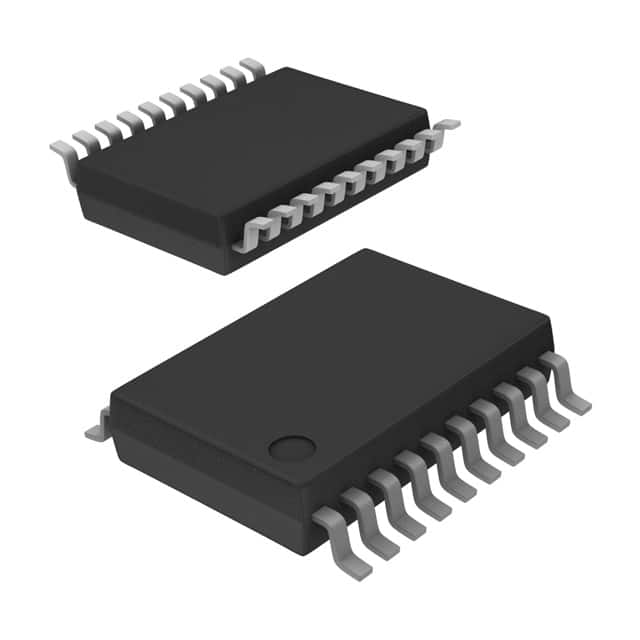Consulte las especificaciones para obtener detalles del producto.

SN74LV244ATDBR
Product Overview
- Category: Integrated Circuit (IC)
- Use: Buffer/Line Driver
- Characteristics: Low-voltage, Octal Bus Buffer with 3-State Outputs
- Package: TSSOP (Thin Shrink Small Outline Package)
- Essence: A high-performance buffer IC designed to provide signal buffering and line driving capabilities in various electronic circuits.
- Packaging/Quantity: Tape and Reel, 2500 pieces per reel
Specifications
- Supply Voltage Range: 1.65V to 5.5V
- Input Voltage Range: 0V to VCC
- Output Voltage Range: 0V to VCC
- High-Level Input Voltage: 0.7 x VCC to VCC
- Low-Level Input Voltage: 0V to 0.3 x VCC
- High-Level Output Voltage: 0.9 x VCC to VCC
- Low-Level Output Voltage: 0V to 0.1 x VCC
- Maximum Operating Frequency: 100 MHz
- Number of Buffers/Drivers: 8
- Output Type: 3-State
Detailed Pin Configuration
The SN74LV244ATDBR has a total of 20 pins, which are arranged as follows:
__ __
1 |* \__/ *| 20
2 | | 19
3 | | 18
4 | | 17
5 | | 16
6 | | 15
7 | | 14
8 | | 13
9 | | 12
10 |_________| 11
Functional Features
- Octal bus interface
- 3-state outputs for bus-oriented applications
- Low power consumption
- High-speed operation
- Compatible with TTL (Transistor-Transistor Logic) input and output levels
- Schmitt-trigger inputs for noise immunity
Advantages and Disadvantages
Advantages: - Wide supply voltage range allows compatibility with various systems - 3-state outputs enable easy bus sharing - Low power consumption helps in energy-efficient designs - High-speed operation ensures quick signal transmission - Compatibility with TTL levels simplifies integration with existing circuits - Schmitt-trigger inputs provide robustness against noise
Disadvantages: - Limited maximum operating frequency compared to some other buffer ICs - TSSOP package may require careful handling during assembly
Working Principles
The SN74LV244ATDBR is designed to buffer and drive signals in electronic circuits. It operates by receiving input signals on its input pins and amplifying them to a level suitable for driving external loads. The 3-state outputs allow the IC to be connected to a shared bus, enabling multiple devices to communicate without interference.
Detailed Application Field Plans
The SN74LV244ATDBR can be used in various applications, including but not limited to: - Microcontroller-based systems - Data communication interfaces - Memory modules - Industrial automation - Automotive electronics - Consumer electronics
Detailed and Complete Alternative Models
Some alternative models that offer similar functionality to the SN74LV244ATDBR are: - SN74LVC244A: Low-voltage CMOS Octal Buffer/Line Driver with 3-State Outputs - SN74HCT244: High-Speed CMOS Octal Buffer/Line Driver with 3-State Outputs - SN74LS244: Octal Buffers/Line Drivers with 3-State Outputs
These alternative models can be considered based on specific requirements such as voltage levels, speed, or compatibility with different logic families.
Word count: 389
Enumere 10 preguntas y respuestas comunes relacionadas con la aplicación de SN74LV244ATDBR en soluciones técnicas
Sure! Here are 10 common questions and answers related to the application of SN74LV244ATDBR:
Q: What is SN74LV244ATDBR? A: SN74LV244ATDBR is a type of integrated circuit (IC) known as a buffer/line driver. It is commonly used for signal amplification and buffering in digital circuits.
Q: What is the voltage supply range for SN74LV244ATDBR? A: The voltage supply range for SN74LV244ATDBR is typically between 2.0V and 5.5V.
Q: What is the maximum output current of SN74LV244ATDBR? A: The maximum output current of SN74LV244ATDBR is typically around 12mA.
Q: Can SN74LV244ATDBR be used for bidirectional communication? A: No, SN74LV244ATDBR is a unidirectional buffer/line driver and does not support bidirectional communication.
Q: What is the maximum operating frequency of SN74LV244ATDBR? A: The maximum operating frequency of SN74LV244ATDBR is typically around 100MHz.
Q: How many channels does SN74LV244ATDBR have? A: SN74LV244ATDBR has 8 channels, meaning it can buffer or amplify signals on 8 different input/output lines.
Q: Can SN74LV244ATDBR handle both TTL and CMOS logic levels? A: Yes, SN74LV244ATDBR is compatible with both TTL and CMOS logic levels, making it versatile for various applications.
Q: Does SN74LV244ATDBR have any built-in protection features? A: Yes, SN74LV244ATDBR has built-in ESD (electrostatic discharge) protection to safeguard against static electricity damage.
Q: What is the package type for SN74LV244ATDBR? A: SN74LV244ATDBR comes in a TSSOP-20 package, which stands for Thin Shrink Small Outline Package with 20 pins.
Q: Can SN74LV244ATDBR be used in automotive applications? A: Yes, SN74LV244ATDBR is suitable for automotive applications as it meets the necessary standards and specifications.
Please note that the answers provided here are general and may vary depending on specific datasheet specifications and application requirements.

